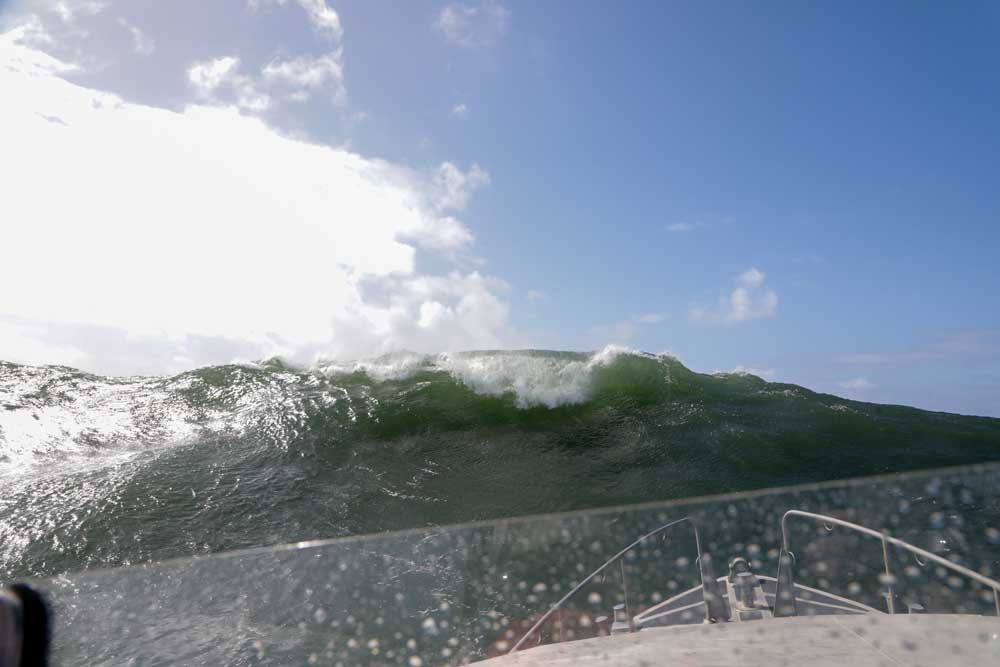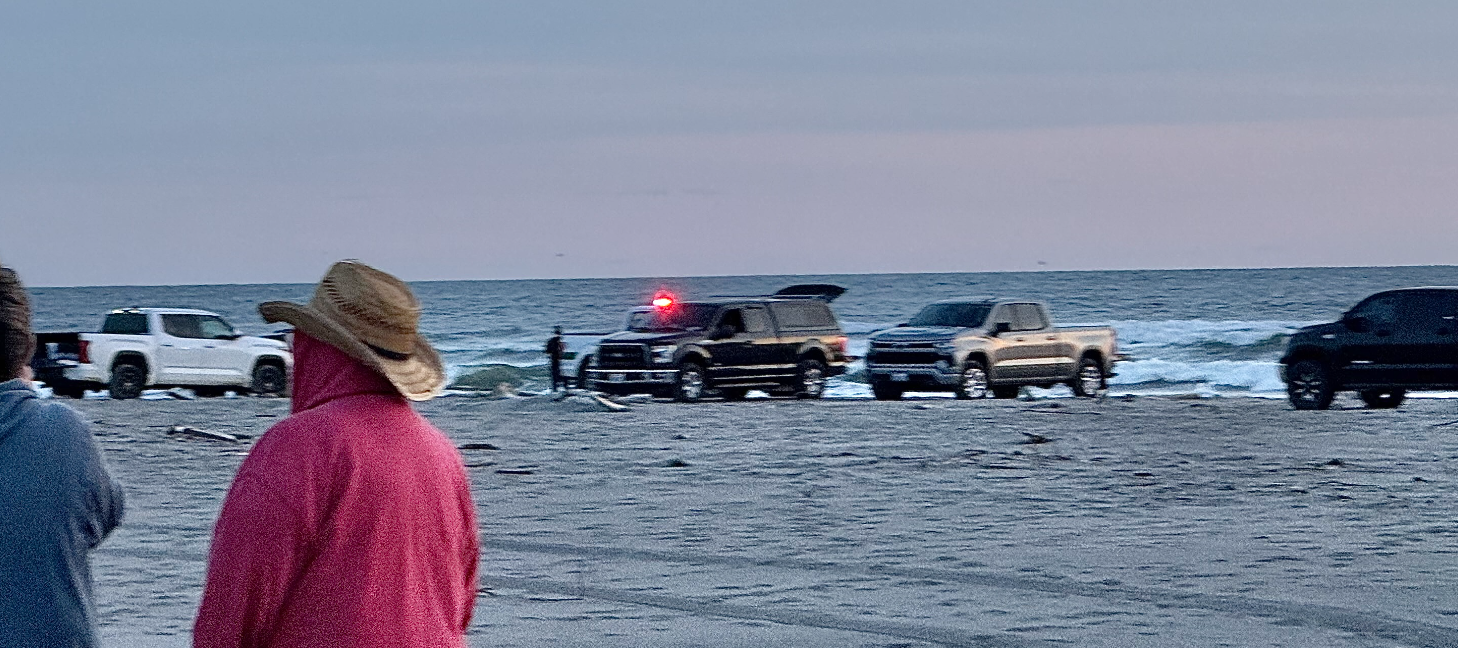“This Nest of Dangers”: As crab season nears, remembering the Triumph-Mermaid disaster
Published 7:26 am Thursday, December 5, 2024

- Breaking 18-foot Benson Beach swells crash over the bow of a 47-foot Coast Guard motor lifeboat in March 2024 — an indication of the kinds of conditions encountered in the winter at the mouth of the Columbia River.
It is a fact of fishing life that those who go out to catch Dungeness crab must do so in winter, starting sometime around Christmas, when the weather can be at its worst. Sou’wester storms roar north up the Oregon and Washington coasts, wreaking havoc along the way.
Local crab fishermen must motor across the Columbia River Bar to work their inshore crabbing grounds.
Their small boats — generally 30- to 60-feet — are equipped with a hydraulic crab block, a mechanism that hoists the 60- to 120-pound steel crab trap by its nylon line. The crewmember hooks his distinctively-colored floating buoy, loops the line over the crab block, retrieves the pot, removing “keeper” crabs, throwing undersized and female crabs back into the water, then re-baits the pot and returns it to the bottom of the ocean. The crew does this for each of their many crab pots. It is hard work.
Crabbers need to lift their pots at least several times a week to prevent their being buried by the shifting sand of the sea floor.
‘Waves, Winds, and Weather’
According to master mariner Nathaniel Bowditch’s “Waves, Winds, and Weather,” the technical term “gale” can indicate a “moderate gale,” a “fresh gale,” a “strong gale,” or a “whole gale.” Wind speeds can vary from 32 to 63 mph, and bridge Beaufort Scale categories 7, 8, 9, and 10.
Sea conditions are described as running the gamut from “sea heaps up, white foam from breaking waves begins to be blown in streaks”; through “moderate high waves of greater length, edges of crests begin to break into spindrift”; then “high waves, sea begins to roll, dense streaks of foam, spray may reduce visibility”; finally to “very high waves with overhanging crests, sea takes white appearance as foam is blown in very dense streaks; rolling is heavy and visibility is reduced.”
The tragedy
(Because of the unimaginable chaos of the memorable 1961 destruction of the Mermaid and the Triumph, contemporaneous reports — as published by regional newspapers — are confused and seemingly uncertain. Therefore, I am using Daryl C. McClary’s internet report “The Long Blue Line: Lest We Forget” as my reference here. McClary is a retired member of the U.S. Coast Guard Reserve.)
On Jan. 12, 1961, the Bergman brothers of Ilwaco, Bert and Stanley, went out in their 34-foot wooden crab boat Mermaid to work their crab grounds. The bar that afternoon was said to have been “rough but passable.”
As they worked, their boat lost its rudder, leaving them adrift in a worsening storm. The Weather Bureau was forecasting an increasingly stronger gale.
Somewhere in the following half-dozen hours, the state of the ocean was described by those involved as producing “mountainous seas,” with winds of 60 mph. As the episode progressed, darkness became absolute, and between that and flying scud (and probably rain) it must have been very hard to see.
Shortly after 4 p.m., the Mermaid’s mayday call was relayed to Cape Disappointment Coast Guard Station by fellow crabber Roy Gunnari of the Jana Jo. “Cape D” responded by dispatching their steel-hulled 40-foot utility boat and a wood-hulled, self-bailing and self-righting 36-foot motor lifeboat.
The bar’s chaos made for a slow transit, but in time the 40-footer reached Peacock Spit and took the Mermaid in tow toward the Bar. The 36-footer rode shotgun for the pair.
As the tow progressed, the Coast Guardsmen onboard the two rescuing vessels came to realize that their boats were not powerful enough to haul the Mermaid to safety. The 40-footer’s skipper radioed Point Adams Coast Guard Station for help from their larger motor lifeboat Triumph.
The 52-foot-long Triumph was a sturdy wood-hulled vessel designed for rough sea conditions. She reached the scene about 7 p.m. and took over the tow. All four boats proceeded to cross into the bar.
(The bar is about six miles long and three miles wide. It is not a short trip, particularly in confused seas. Its length is filled with shifting sand and debris; that material is constantly shoved around by movement of the water column, making for a changing bottom depth. That, plus tall waves with deep troughs, can momentarily slam a boat on the bottom, causing it to spring a leak.)
The bar is about six miles long and three miles wide. It is not a short trip, particular in confused seas. Its length is filled with shifting sand and debris…
A progression of “extremely large breakers” overtook the 40-footer and abruptly sank her. Her three crewmembers were thrown into the water.
The 36-foot motor lifeboat was capsized but righted herself, damaging her hull on the sinking 40-foot utility boat and springing a leak. She picked up the utility boat’s crewmen.
Her skipper then made a life-saving decision for himself and the other five crewmen, turning and making for the Columbia River Lightship, which was anchored several miles offshore. (Early the next morning, that 36-footer would sink while tied to the lightship.)
The skipper also radioed Point Adams about the loss of the 40-footer. The station sent out two 36-foot motor lifeboats to assist the rescue in progress.
About 7:30 p.m., after the Triumph had taken the Mermaid in tow, the four-inch hawser connecting them snapped, leaving the crabber adrift. The USCG crew passed another line, but it too parted.
Next, the Mermaid called the Coast Guard stations to report that the Triumph had capsized and that she — the Mermaid — was drifting into breakers.
When the two 36-foot motor lifeboats from Point Adams arrived at the scene, the Triumph was not visible.
Shortly after 9 p.m., one of those motor lifeboats reached the Mermaid and took her in tow, turning for the lightship. While that tow was underway, a “giant wave” overwhelmed the Mermaid, breaking her towline and sinking her, killing the Bergmans and the one Triumph crewman they had hauled from the water.
Meanwhile, the Triumph slowly righted itself, allowing Engineman Gordon Huggins, who had been below decks when she capsized, to get topside. At this point, the vessel was thrashing around in 20- to 30-foot breakers with an engine that refused to start. After an hour of chaos, the Triumph rolled again, throwing Huggins overboard. After enduring the ocean’s long “spin cycle,” he washed ashore on Benson Beach, where a Cape Disappointment rescue crew found him and got him to Ilwaco’s hospital.
Horrible ordeal
This horrible ordeal cost the lives of seven men and four boats. It stunned the locals and shocked the Coast Guard. It is 60 years later and yet the community remembers the Triumph/Mermaid disaster with sober awe.
There is a monument to those lost at Seafarer’s Park on the river, just north of Hammond, Oregon.
You will see a life ring with the name Mermaid stenciled on it at The Coffee Girl coffee shop out at Pier 39 in east Astoria.
(On a personal note, one day as I was at the Columbia River Maritime Museum, focused on an exhibit about this disaster, a man spoke to me. As I shifted my attention to him, he grinned, stuck out his hand, and said, “I’m Gordon Huggins.” I grinned back and returned his hearty handshake. I’ll never forget him.)





